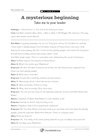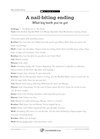Play time
Add to My Folder
Use the ‘At home with the Robinsons’ poster to plan, script and act out your own class adventure stories.
Children relish role play. At breaktime they transform themselves into superheroes and monsters, film stars and spies, and instinctively adapt the way they speak or stand. So why not bring role play into the classroom too? Not only does it allow children to develop plot and dialogue – it is great fun as well.
Unlike formal script writing, ideas can be discussed and explored before they are firmly fixed. Stories can be allowed to twist and turn. Different voices can be tried, and inventive sound effects can be added. In short, the imagination can blossom and astonishing things can happen.
Setting the scene
- The plays that you and your class devise will be based on the A1 poster ‘At home with the Robinsons’. So begin by enjoying and exploring the picture together. Give the children time to study and discuss all the different scenes. In some, an extraordinary event is about to happen – this could form the beginning of a play. In other scenes, something dramatic has already happened – this could become the middle or the ending of a play.
- Ask the children to focus on one particular scene, such as the garden. Tell them to list all the separate dramas taking place in this one area, and choose one to dramatise together – the boy and his can of magical Giant Grow, for example. Ask for volunteers to pretend to be the boy. What is he saying to himself? Did he make the magic potion, or was he given it? Is he a naughty person – or a nasty one? Let the class offer suggestions and choose their favourites.
- Now divide the class into small groups and ask them to add
two more characters to the scene. Perhaps the Witch gives the can to the boy, and then he accidentally spills some of the liquid into the pond. Perhaps the old lady next door has stolen some of it. Perhaps the dog is trying to escape from the hungry (or friendly?) Pond Monster! - The children should invent distinctive voices and sound effects for all their characters (especially the Pond Monster). They must also decide whether the boy is to be rescued, or whether he comes to a sticky end! Once the short scenes are ready, they can be recorded in two ways: first as a storyboard, with simple cartoons and speech bubbles. Second, as a radio play – complete with sound effects, announcers and even some dramatic music. The sounds of plants growing and monsters gurgling will test everybody’s ingenuity.
- Finally, if you have made recordings, listen to the performances and ask the children to suggest improvements. (And don’t forget to give yourselves a big round of applause at the end!)
Already a member? Sign in below.
Published 26 September 2007
Reviews
You need to be signed in to place a review.



